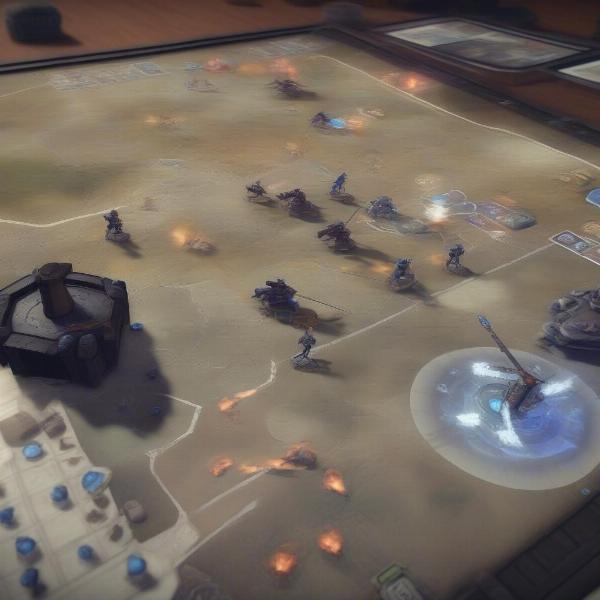Pausing a game seems simple enough, right? Just hit the Esc key or the designated pause button on your controller. But behind this seemingly straightforward action lies a surprisingly complex world of game design and technical wizardry. Understanding what pausing a game truly means goes beyond simply freezing the action; it involves delving into how games manage time, resources, and player agency.
Similar to how long a football game college takes, pausing can significantly impact the overall experience. After this seemingly simple act, the game world freezes, giving players a breather to strategize, admire the scenery, or deal with real-life distractions. But this frozen state is anything but static under the hood. A multitude of processes are at play, carefully orchestrated to ensure a seamless transition back into the heart of the action. Let’s explore the intricacies of the pause game mechanic, from its basic function to its more advanced implications in different game genres.
The Mechanics of Pausing: More Than Just Freezing Time
What happens when you hit that pause button? At the most basic level, the game’s internal clock stops ticking. Character movements, enemy AI, physics calculations, and even background animations are all put on hold. This freeze allows players to step away from the game without being penalized. However, not all game elements are necessarily paused. Some background processes might continue running, such as music playback or network communication, depending on the game’s design and the platform it’s running on. It’s a delicate balance of maintaining the illusion of a frozen world while keeping essential systems active.
Different Types of Pausing
The pause function isn’t always a simple on/off switch. Different games implement pausing in various ways. Some games offer a “soft pause,” where the game world appears frozen, but certain elements, like menus or in-game timers, continue to function. This is common in online multiplayer games to prevent pausing from disrupting other players’ experiences. Other games might feature a “tactical pause,” allowing players to issue commands and strategize while the game is paused, adding a layer of strategic depth to the gameplay.
The Impact of Pausing on Different Game Genres
The role of pausing varies greatly depending on the game genre. In fast-paced action games, pausing can be a crucial tool for survival, allowing players to quickly assess a situation and plan their next move. In contrast, in real-time strategy games, pausing might offer a tactical advantage, letting players issue commands and adjust their strategy without the pressure of real-time gameplay. The ability to pause can also greatly enhance the immersive experience in narrative-driven games, allowing players to savor the story and atmosphere at their own pace.
 Pausing in Action Games
Pausing in Action Games
In online multiplayer games, pausing can be a contentious issue. While it might benefit one player, it can disrupt the experience for others. This is why many online games either restrict pausing or implement alternative systems, like “soft pauses” or designated safe zones where pausing is allowed.
Pausing and the Player Experience
The ability to pause can significantly impact the player experience. It provides a sense of control and allows players to manage their gameplay according to their individual needs and preferences. This can be especially important for players who need to take breaks for real-life interruptions. However, excessive pausing can also disrupt the flow of gameplay and diminish the sense of immersion. It’s about finding the right balance between providing player agency and maintaining the integrity of the game experience. Some games even incorporate pausing as a game mechanic itself, adding a layer of complexity and strategic depth.
The Future of Pausing
As gaming technology continues to evolve, we can expect to see further innovations in how pausing is implemented. Virtual reality and augmented reality games present unique challenges and opportunities for pausing, as pausing the real world isn’t exactly an option! We might see more creative solutions emerge, such as blurring the real world while the game is paused or integrating pause functions seamlessly into the VR/AR experience.
 VR/AR Pause Mechanics
VR/AR Pause Mechanics
Exploiting the Pause: Speedrunning and Sequence Breaks
The humble pause button has also found a surprising application in the world of speedrunning. Speedrunners often use pausing to manipulate game mechanics, perform frame-perfect inputs, and execute complex glitches. This allows them to shave precious seconds off their runs and discover unconventional routes through the game.
Similar to how you might want to know where can i watch the uk game, speedrunners constantly seek optimal pausing strategies. Pausing can also be instrumental in discovering sequence breaks, allowing players to access areas of the game earlier than intended. These unintended exploits can add an exciting layer of depth to the speedrunning community, pushing the boundaries of what’s possible within a game.
Designing the Pause: A Developer’s Perspective
From a developer’s perspective, implementing a pause function is far from trivial. It requires careful consideration of how different game systems interact and how pausing will affect the overall player experience. Developers must balance the need for a user-friendly pause function with the technical constraints of the game engine and the platform it’s running on. It’s a delicate balancing act that can significantly impact the overall quality and playability of the game.
 Game Development Pause Design
Game Development Pause Design
For example, consider how freshman football games are structured. The pause mechanic needs to be tailored to the specific flow and pace of the game. How long are freshman football games? Even slight variations in game length can impact how often and for how long players will utilize the pause feature. This underscores the need for a well-designed and implemented pause mechanic. Think about how to close game on ps5; developers need to ensure a smooth transition between gameplay and the paused state. Similarly, understanding how many in-game seconds happen a second in a game like Lethal Company can influence how developers design the pause functionality to ensure accurate time management within the game world.
Conclusion
So, What Is The Pause Game? It’s more than just hitting a button; it’s a complex interaction between player, game, and technology. It’s a fundamental aspect of game design that can enhance the player experience, provide strategic advantages, and even open up new possibilities for exploration and exploitation. From its technical underpinnings to its impact on gameplay and player agency, the pause game mechanic continues to be an integral part of the gaming landscape. Consider how pausing impacts your gameplay next time you hit that button, and appreciate the intricate mechanics at play behind this seemingly simple action.
FAQ
- Can I pause online multiplayer games? It depends on the game. Some games restrict pausing entirely, while others offer alternative systems like soft pauses or designated safe zones.
- What is a tactical pause? A tactical pause allows players to issue commands and strategize while the game is paused.
- How does pausing work in VR/AR games? VR/AR games present unique challenges for pausing. Developers are exploring innovative solutions like blurring the real world or integrating pause functions directly into the VR/AR experience.
- How do speedrunners use pausing? Speedrunners use pausing to manipulate game mechanics, perform frame-perfect inputs, and execute complex glitches.
- Why is pausing important for game design? Pausing gives players control over their gameplay, allowing them to take breaks and manage their experience.
- What are the different types of pausing? Common types include full pauses, soft pauses, and tactical pauses.
- Can pausing be a game mechanic itself? Yes, some games incorporate pausing as a core gameplay mechanic, adding a layer of complexity and strategy.

